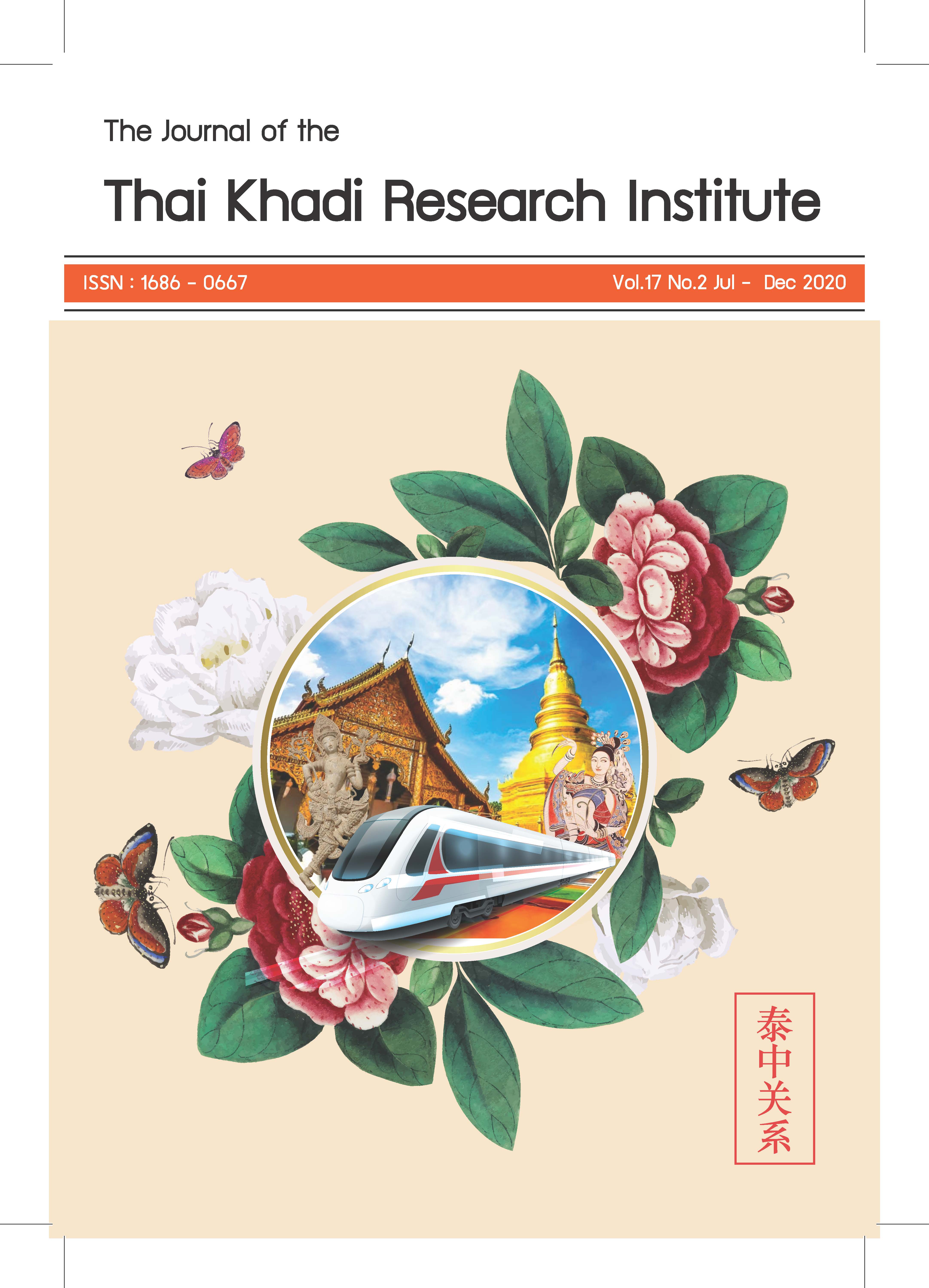การปรับเปลี่ยนความสัมพันธ์ทางสังคม ของชาวจีนฮกจิว อำเภอนาบอน จังหวัดนครศรีธรรมราช พ.ศ. 2468 - ปัจจุบัน
Main Article Content
บทคัดย่อ
บทความนี้มีจุดมุ่งหมายในการนำเสนอว่า ความสัมพันธ์ทางเศรษฐกิจของ ชาวจีนฮกจิวที่แฝงฝัง (Embedded) กับความสัมพันธ์ทางสังคมในช่วงแรกเริ่มของการตั้งถิ่นฐานเพื่อบุกเบิกพื้นที่ทำสวนยางพาราในภาคใต้ เป็นปัจจัยและเงื่อนไขสำคัญที่ทำให้ชาวจีนฮกจิวโพ้นทะเลในสังคมไทยประสบความสำเร็จ ทว่า เมื่อชีวิตทางเศรษฐกิจของชาวจีนฮกจิวปรับตัวสัมพันธ์กับวิถีการผลิตและการค้ายางพาราสมัยใหม่ ทำให้ความสัมพันธ์ทางเศรษฐกิจของชาวจีนฮกจิวปรับเปลี่ยนเป็นความสัมพันธ์เชิงพาณิชย์มากขึ้น และความสัมพันธ์ทางสังคมแบบเดิมแปรเปลี่ยนเป็นเพียงมิติวัฒนธรรม อย่างไรก็ดี ความสัมพันธ์ทางสังคมของชาวจีนฮกจิวที่ขับเคลื่อนผ่านองค์กรทางสังคมวัฒนธรรม เป็นโอกาสแห่งความหวังในการเปิดรับความสัมพันธ์ทางการค้าและการลงทุนกับจีนแผ่นดินใหญ่ท่ามกลางบริบททุนนิยมจีนที่แผ่ขยายมายังชุมชนจีนโพ้นทะเลทั่วโลก
Downloads
Article Details
ผู้เขียนจะต้องลงนามในแบบฟอร์มรับรองบทความ เพื่อให้คำยืนยันความรับผิดชอบว่า บทความของผู้เขียนนั้นไม่เคยตีพิมพ์ที่ใดมาก่อน พร้อมรับทราบว่า กระบวนการส่งบทความเข้าพิจารณาและตีพิมพ์ในวารสารไทยคดีศึกษานั้น จะไม่มีการเรียกเก็บค่าใช้จ่ายในการดำเนินการ ยกเว้น ในกรณีที่ผู้เขียนขอยกเลิกการตีพิมพ์บทความในวารสารไทยคดีศึกษาไม่ว่าด้วยสาเหตุใด และหลังจากบทความนั้นเข้าสู่กระบวนการพิจารณาของผู้ทรงคุณวุฒิไปแล้ว ผู้เขียนจะต้องรับผิดชอบต่อค่าใช้จ่ายที่เกิดขึ้นในกระบวนการประเมินเป็นจำนวนเงิน 3,000 บาท (สามพันบาทถ้วน)
เอกสารอ้างอิง
Chuenchoksan, S. (2010). Tamnān sư̄a phư̄n mō̜n bai: sutyō̜t hūačhai khon sū chīwit [The legend of the pillow mat: The best in the life]. Bangkok: Fuzhou Association of Thailand.
Fei, Ch. (2010). Phư̄n thin phǣndin Čhīn: sangkhomwitthayā chonnabot Čhīn [Folkland of China: Chinese Rural Sociology]. Bangkok: Torch Printing Project.
Gold, T., Guthrie, D. & Wank, D. (eds.). (2004). Social Connections in China: Institutions, Culture and the Changing Nature of Guanxi. UK: Cambridge University Press.
Guitong, Ma. (2017). Watthanatham kūan sī kap kānsāng khrư̄akhāi thāng sangkhom khō̜ng chāo Thai chư̄asāi Čhīn hā kakā nai phư̄nthī phāk tai tō̜n lāng khō̜ng prathēt Thai [The “Guanxi” culture and the creation of social networks of Chinese Hakka in Lower Southern Thailand] (Doctoral thesis, Thaksin University).
Kalakan, W. (1985). Nayōbāi kānphalit læ kānkhā yāngphārā nai phāk tai khō̜ng Thai [Rubber production and trade policy in southern Thailand] (Master’s thesis, Chulalongkorn University).
Kaewsuwan, N. (1994). Phatthanākān khō̜ng kānphalit læ kānkhā yāngphārā nai phāk tai khō̜ng Thai Phō̜.Sō̜. sō̜ngphansīrō̜i pǣtsippǣt - sō̜ngphanhārō̜isiphok [Development of rubber production and trade in southern Thailand 1945 - 1973] (Master’s thesis, Chulalongkorn University).
Kittipol, L. (2011). Fuzhou Association of Thailand. Bangkok: Fuzhou Association of Thailand.
Langenberg, Eike A. (2007). Guanxi and Business Strategy: Theory and Implications for Multinational Companies in China. New York: Physica - Verlag Heidelberg.
Laungaramsri, P. (2011). Livelihoods. Faculty of Social Science, Chiangmai University.
Lee, Edward Yiu Chung. (2014). The Contemporary role of guanxi in Chinese entrepreneurship (Doctoral thesis, Robert Gordon University).
Limlertwathee, Y. (2016, January 26). Bidā kān yāng hǣng sāthāranarat prachāchon Čhīn kō̜kamnœ̄t čhāk phāk tai prathēt Thai thī chumchon yāng nāp ʻon [Father Rubber of the People’s Republic of China originated from the southern region Thailand at Nabon Rubber Community]. Retrieved January 26, 2016, from https://mgronline.com/south/detail/959000 0009068.
Limlertwathee, Y. (2016, June 11). Ratthabān thō̜ngthin Čhīn nam khana yư̄an ampore Nabon, Nakorn sri Thammarat “thin kamnot bidā kān yāng Čhīn” krachap samphan thāngkān khā [The Chinese local government led the group to visit Nabon district, Nakhon SI Thammarat province: Chinese rubber strengthen trade relations]. Retrieved June 26, 2016, from https://mgronline.com/south/detail/9590000058578.
Lin, F. (1996). Wādūai rư̄ang sāisamphan hā laksana læ sangkhom chāo Čhīn phōnthalē (klum chāo Čhīn) nai Thai. In chāo Čhīn Tǣčhiu nai prathēt Thai læ nai phūmilamnao dœ̄mthī chaosan: samai thī sō̜ng thārư̄a sān thōwa (sō̜ngphansīrō̜isām - sō̜ngphansīrō̜ikāosipsō̜ng) rư̄ (nưngphanpǣtrō̜ihoksip - nưng phankāorō̜isīsipkāo) [The Teochew Chinese people in Thailand and in the original residence in Cao San: Second period Shantou Port (1960 - 1949)]. Bangkok: Asian Studies Institute, Chulalongkoen University.
Musikkasarn, W. (1980). Kānsamrūat phư̄nthī plūk yāngphārā dōi chai khō̜mūn čhāk dāothīam [Exploring rubber plantation areas using satellite data]. Journal of Rubber. 1(3), 136 - 142.
Polanyi, C. (2016). The great Transformation: The political and Economic Origins of Our Time. Nonthaburi: sameskybooks.
Pongpaiboon, S., Wutpanit, D. & Chinnakan, P. (2011). Čhīn Thaksin: withī læ phalang [China in the south: Way and Power]. Bangkok: The Thailand Research Fund.
Rubber Research Institute, Department of Agriculture. (2014). Sưksā khrōngsāng kānphalit læ withī kāntalāt yāngphārā Thai [Study the production structure and marketing methods of Thai rubber]. In Rāingān phon kānwičhai rư̄ang tem pračham pī 2556 [Full - Year Research Report 2013]. Bangkok: Rubber Research Institute, Department of Agriculture.
Shanshan, Q. (2012). The Role of guanxi in Chinese Entrepreneurship: A qualitative study on how Chinese entrepreneurs make use of guanxi networks during the development of micro firms (Master’s thesis, Umea University).
S.H. Khoo, G. Cho. & K.E. Chan. (1972). Spatial Aspects of Foochow Settlement in West Malaysia with Special Reference to Sitiawan, Perak, since 1902. Asian Studies, Vol. X(1 April), 77 - 94.
Songprasert, P. (1992). Thun singkhapō: kān phūkkhāt talāt yāngphārā læ dībuk Thai [Capitalist of Singapore: The monopoly of Thai rubber and tin markets]. Bangkok: Institute of Asian Studies, Chulalongkorn University.
Songprasert, P. (2003). Thun Čhīn pak tai: phūm lang bư̄ang lưk thun yai phōnthalē [Capitalist of the South: Deep background of overseas capital]. Bangkok: Tipping Point.
Sutthisong, S. (1986). Kānphalit læ kānchai yāng thammachāt khō̜ng prathēt Thai [Production and use of natural rubber in Thailand]. Journal of Rubber, 7(1), 32.
Teck Ghee, L. (1977). Peasants and their Agricultural Economy in Colonial Malaya, 1874 - 1941. Kuala Lumpur: Oxford University Press.
Interviewees
Kanopthammakul, S. Officer. 20 April 2017.
Panpipat, S. Entrepreneur. 26 December 2017.
Sintunont, Api. Entrepreneur. 14 February 2018.
Tachinnithipong, N. Entrepreneur. 1 December 2017.
Tantipisit, S. Rubber plantation owner. 16 June 2015.
Thawornwongsa, S. Entrepreneur. 15 June 2015.
Tinnachartarak, K. Rubber plantation owner. 28 December 2017.
Tinnachartarak, J. Rubber plantation owner. 28 December 2017.
Wangthananurak, W. Guardian of the shrine. 13 May 2018.
Watcharawijit, Udom. The President of Fuzhou Association of Thailand. 2 April 2018.
Uwanitkul, W. Entrepreneur. 15 June 2015.


